Driving commercial and political engagement between Asia, the Middle East and Europe
Driving commercial and political engagement between Asia, the Middle East and Europe
Driving commercial and political engagement between Asia, the Middle East and Europe
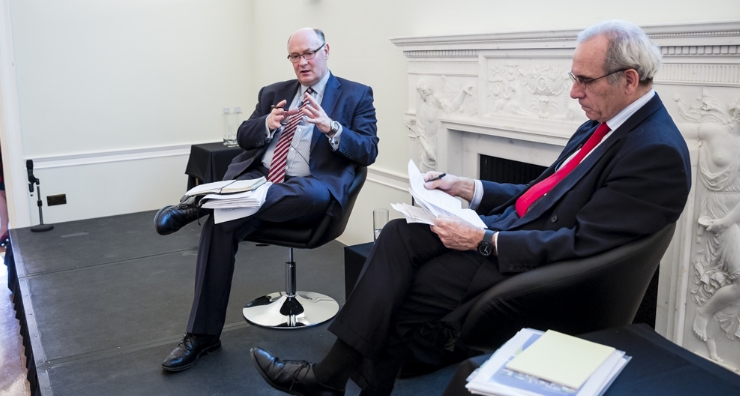
The long-awaited emergence of India as a new regional powerhouse and the increasing integration of ASEAN economies are the new drivers of growth in Asia, now that the Chinese economy, hitherto the region’s engine of growth, is beginning to slow down.
Asia faces huge demand both for infrastructure and the financing of that infrastructure to meet the needs of its growing middle-class. Greater inter-region connectivity, more ports , airports, roads and houses, as well as investment in broadband, ICT infrastructure, health and education are all required as the current infrastructure lags behind the region’s economic growth.
Asia currently has over four billion people, 60 per cent of the world’s population and its GDP is 25 per cent of world GDP. But by 2050 Asia is predicted to account for half the world’s GDP.
HSBC, which celebrates its 150th anniversary this week, has always gone against the trend and been more optimistic about Asia and invested in trade flows to the region, said Douglas Flint, Group Chairman of HSBC Holdings, one of the keynote speakers at Asia House’s signature conference entitled Access Asia – Making Connections, organised in partnership with the bank.
“HSBC was founded on and is dedicated to supporting trade flows in the world. That creates prosperity so that a lot of people can fulfil their own dreams and ambitions,” Mr Flint said.
He said creating and improving trade flows to and from Asia would greatly benefit UK-based SMEs who could find new opportunities to sell their goods and services overseas. “They can connect much more than they could before, particularly through the finance system,” he said.
However, whilst investment in trade and infrastructure would be the key drivers of economic growth in Asia, the raft of regulations imposed on banks since the 2008 financial crisis had made the financing if it more difficult, he said.

Douglas Flint, Group Chairman of HSBC Holdings. Copyright Miles Willis Photography
“If emerging markets consume resources like the West it will not be do-able, so investment in infrastructure needs to be done in a different way, which is also challenge, “ he added. “Investment is needed in power and broadband,” he said.
In fact, Asia needs US$8 trillion of infrastructure investment between now and 2020, according to the Asian Development Bank (ADB), the Manila-headquartered financial institution set up in 1966 to finance and partner development in Asia.
Approximately half of that money is needed to invest in energy infrastructure, a third for transport, 13 per cent for ITC and three per cent for water and sanitation.
India alone needs US$1.7 trillion and Indonesia needs US$570 billion in infrastructure investment.
Thierry de Longuemar, Vice President (Finance and Risk Management) of the ADB, also a keynote speaker at the conference, said: “A lack of infrastructure in Indonesia has cost the country three to four per cent of its GDP per year.”
The United Nations predicts that nearly all population growth will take place in the urban areas of developing countries in the future with an estimated four billion people living in cities and towns in the developing world by 2030. In fact China, India and Nigeria are expected to account for more than a third of the increase of 2.5 billion people in the world’s urban population by 2050, with India expected to see an additional 404 million people in its urban areas and China an extra 292 million.
“There is no doubt there is a need to invest in infrastructure, inter-regional connectivity and education,“ Mr de Longuemar said.
The ADB does precisely that. It finances infrastructure, energy, water, urban development and transport in Asia. But it is also involved in food security, climate change and gender equality in the region.
“We are the primary partner for development in Asia and run by Asians,” Mr de Longuemar said, pointing out the majority of the ADB’s 67 shareholders were Asian countries. “The bank was mainly set up to provide solutions to Asians. We are unique in how we provide cheap funding. There are many sovereign wealth funds eager to invest and they need the expertise we can provide in terms of infrastructure project management.”
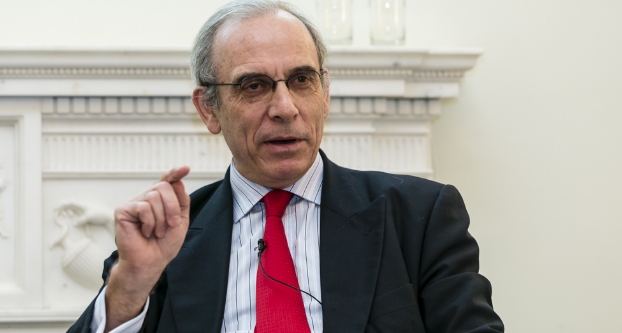
Thierry de Longuemar, Vice President (Finance and Risk Management) of the Asian Development Bank. Copyright Miles Willis Photography
But the ADB, which has US$162 billion in capital and a triple-A credit rating, only lends about $20 billion a year for infrastructure – leaving plenty of scope for other banks, such as the China-led Asian Infrastructure Investment Bank (AIIB), to help bridge the infrastructure financing gap. The AIIB, expected to start operations in 2016, would help supply much-needed capital for infrastructure development across the region.
Mr de Longuemar said he viewed the AIIB as “healthy competition.” “It might force the ADB to transform itself,” he said.
He added the BRICS bank headquartered in Shanghai set up last year by the five BRICS nation – Brazil, Russia, India, China and South Africa – to counterbalance western-led finance institutions and finance infrastructure projects was barely spoken about, but it is another significant player in this field.
Poverty in Asia
One of the primary objectives of the ADB, when it was created, was to make the Asia-Pacific region poverty-free, an objective not yet achieve. Despite Asia’s huge growth forecast, 1.7 billion Asians still live on under US$2 a day and there remain huge wealth disparities. Three hundreds and sixty million Asians currently have no access to drinking water and nearly two-thirds of the world’s poor currently live in developing Asia.
“Singapore and Hong Kong are highly developed; Cambodia and Nepal are not well developed,” Mr de Longuemar said. To achieve prosperity in the less developed markets, high quality infrastructure was needed as well as “human capital that matched the needs of the job market,” he said.
He said these countries also needed to improve their governance, improve their attractiveness to investment, improve equality and improve inclusiveness.
“Demand is huge and the public sector is strained so what we are telling governments is to set priorities, better identify sources of revenues and deepen and transform regional capital markets. Currently financing of infrastructure is dependent on banks in Asia, with 80 per cent coming from banks and 20 per cent from bond markets. I am not sure the Basel III committee was properly advised. If you bar banks from buying corporate bonds, you can’t expect these markets to develop. We are trying to convince governments to use public-private partnerships (PPPS) more effectively,” he said. Indian Finance Minister Arun Jaitley spoke about the need to revisit and revitalise the PPP model to increase investment in infrastructure projects in India in his recent Union Budget speech.
The gap between rich and poor has widened in China, Indonesia and India in recent years, despite these being the three fastest growing economies in the region. The income gap in China is now wider than that of the US.
China was now seeing its growth falter. It grew at 7.4 per cent in 2014 and is expected to grow at just 7.2 per cent in 2015. “Meanwhile prospects are improving in India,” Mr de Longuemar said. “There is a shift whereby China will provide lower growth rates and India will become the leading economy of the Asian region. We are moving from a China-led Asian economy to an India-led one,” he said.
Mr de Longuemar pointed out that whilst Europe and North America were the number one trading partners of Asia currently, this was set to change in favour of more inter-regional Asian trade owing to a perceived over-reliance on trade with the West. The formation of the ASEAN Economic Community (AEC) was helping achieve this. “China has moved away from export-led growth, ASEAN is trying to increase its presence on the world stage and Central Asia is trying to diversify away from commodities in the light of the drop in commodity prices,” he pointed out.
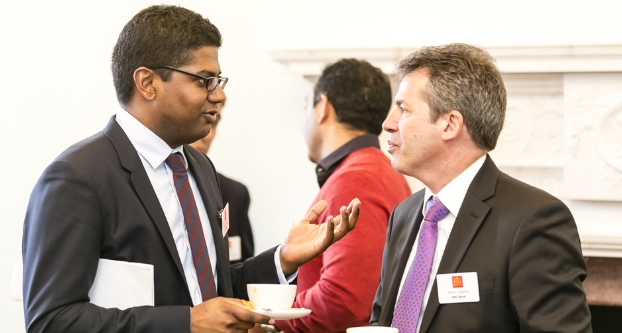
Delegates network during the coffee break at the Access Asia – Making Connections conference. Copyright Miles Willis Photography
Various expansions by road, rail, air and sea to link up China with South, Southeast and Central Asia were in the pipeline such as China’s initiative to build a “Silk Road Economic Belt” and the 21st Century ‘Maritime Silk Road’, similar to the historical route centuries ago – except then the trade was in silk and spices. Other initiatives include the Bangladesh China India Myanmar Economic Corridor, the Singapore-Kunming Rail Link and the Asian Highway Network, all of which would help inter-regional connectivity and boost multilateral trade.
Stephen King, Group Chief Economist at HSBC, said: “The world economy is reverting back to how it was 1,000 years ago when Asia and East Africa were the centres of world trade and Europe and the UK were on the periphery. Infrastructure, especially coastal infrastructure, is a very important part of that story.”
However Mr de Longuemar noted: “The integration of Asia is lagging behind what’s happening in other parts of the world. It’s behind because there is no political will yet – except for the ASEAN community but that’s just 10 out of 40 countries so there is a lack of focal point and many things that need to be improved.”
Luky Eko Wuryanto, Deputy Minister of Infrastructure and Regional Development, Coordinating Ministry for Economic Affairs, Indonesia, said: “We want to compete with other nations and grow our economy much faster. The allocation of our budget from the overhaul of the fuel subsidy system is going mostly on infrastructure. We have to engage more with state owned enterprises and develop the maritime route.”
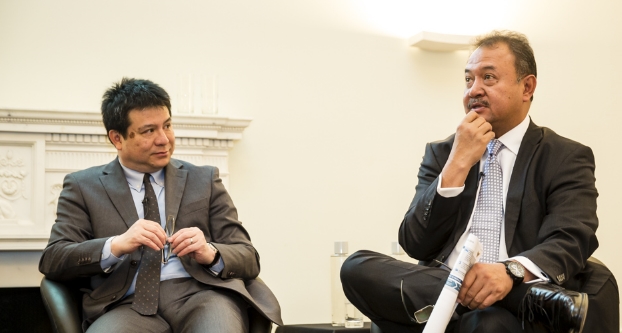
James Yim, Head of Strategy and Portfolio, BP Downstream, left, with Luky Eko Wuryanto, Deputy Minister of Infrastructure and Regional Development, Coordinating Ministry for Economic Affairs, Indonesia, right. Copyright Miles Willis Photography
Astanah Abdul Aziz, Deputy Director General, ASEAN Economic Community Division, Ministry of Foreign Affairs, Malaysia, said that the ASEAN Community consists of three pillars: political, economic and social/cultural. A Master Plan for ASEAN Connectivity (MPAC) looking at physical, institutional and people-to-people connectivity was adopted in 2010. The aim was to reduce the development gap within and among ASEAN nations. As for the proposed ASEAN-EU FTA, which would be the first region-to-region FTA, she said: “We are still pushing for it but ASEAN economic integration [to transform ASEAN into a single market and production base] comes first. The aim is to achieve that this year. When it comes to PPP, we [Malaysia] are ahead of the curve in Asia,” she said, adding discussions regarding the Trans-Pacific Partnership (TPP), a regional regulatory and investment treaty currently involving 12 countries, were ongoing.
Singapore became the first ASEAN county to conclude FTA negotiations with the EU in 2014 and the EU is negotiating FTAs with Malaysia, Vietnam and Thailand.
Ranieri Sabatucci, Head of the South-East Asia Division of the European External Action Service (EEAS), said : “Ninety per cent of growth will take place outside of Europe in the future and most of that will be in Asia, so our challenge is to hook onto this growth. There are 125 million middle-class households in the ASEAN region alone. We hope they will be interested in European products and services and travel to Europe. These middle-classes are likely to be interested in the same issues as us: climate change, environment protection and so we are betting on Asia for many reasons.”
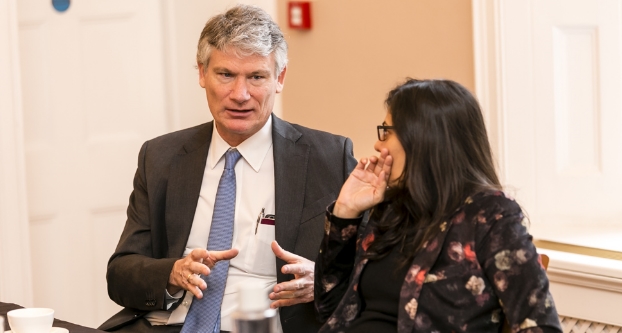
Ranieri Sabatucci, Head of the South-East Asia Division of the European External Action Service (EEAS), left with Astanah Abdul Aziz, Deputy Director General, ASEAN Economic Community Division, Ministry of Foreign Affairs, Malaysia, right. Copyright Miles Willis Photography
“The people moving from rural areas to cities in Asia want to move within and between those cities so the rise of middle-income Asia is putting a greater pressure on cities, “ said James Stewart, Global Infrastructure Chair, KPMG. “We need more airports, interlinking airports and ports. Urban mobility is going to be a big trend. The world over deals are stuck in the development pipeline with many never reaching construction and that is the single biggest challenge facing us,” he said. Another challenge was the political and regulatory risks the entire world was facing. “Investors like low-risk investments and Asia needs to demonstrate it has a long-term stable economy,” he added.
James Lockett, Vice President, Head of Trade and Facilitation and Market Access for Huawei Group, said the future was eRoads, ePorts and the Internet of Everything, with technology bringing huge benefits in infrastructure, education and health, especially to remote areas of Asia.
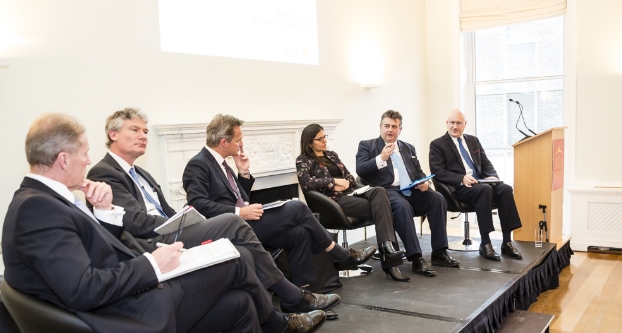
From left: Michael Lawrence, CEO of Asia House; Ranieri Sabatucci, Head of the South-East Asia Division of the EEAS; Rupert Hogg, Director and CEO of Cathay Pacific; Astanah Abdul Aziz, Deputy Director General, ASEAN Economic Community Division, Ministry of Foreign Affairs, Malaysia; Philip Bouverat, Director, JCB and James Lockett, Vice President, Head of Trade and Facilitation and Market Access for Huawei Group. Copyright Miles Willis Photography
Rupert Hogg, Director and Chief Operating Officer of Cathay Pacific, said China was doing the most in infrastructure. It has built 75 airports in the last three years. “They have gone from nowhere to a 3,000km train track in the same period,” he said. Manila and Jakarta airports were operating at twice their published capacity and Hong Kong was already full and in need of a third runway. “If we don’t build the infrastructure we will end up with distorted traffic flows and markets,” he said.
“Some petrochemical products can be shipped to India cheaper than within India. For India to compete with China, infrastructure is a big part of it,” added Head of Strategy and Portfolio, BP Downstream James Yim.
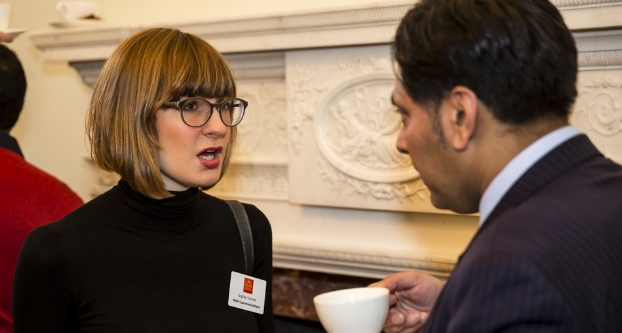
Delegates network during the coffee break at the Access Asia – Making Connections conference. Copyright Miles Willis Photography
naomi.canton@asiahouse.co.uk
Our next Breakfast Briefing for corporate members will analyase the impact of Narendra Modi’s first full year Budget. Richard Rekhy, the CEO of KPMG in India and Sanjeev Sanyal, Global Strategist and Managing Director for Deutsche Bank, will brief Asia House corporate members on India’s Union Budget on 17 March. For more information click here.
